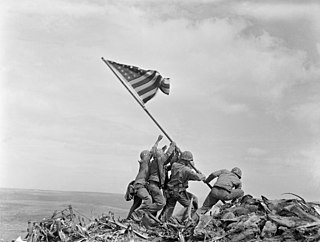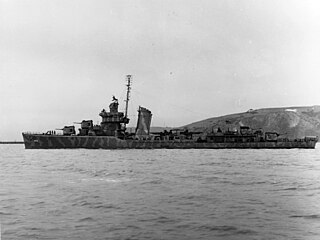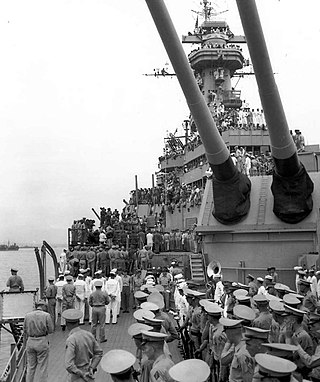
Zuikaku was the second and last Shōkaku-class aircraft carrier built for the Imperial Japanese Navy (IJN) shortly before the beginning of the Pacific War. Her aircraft took part in the attack on Pearl Harbor that formally brought the United States into the war, and she fought in several of the most important naval battles of the war, before being sunk during the Battle of Leyte Gulf.

The Asiatic-Pacific Theater was the theater of operations of U.S. forces during World War II in the Pacific War during 1941–1945. From mid-1942 until the end of the war in 1945, two U.S. operational commands were in the Pacific. The Pacific Ocean Areas (POA), divided into the Central Pacific Area, the North Pacific Area and the South Pacific Area, were commanded by Fleet Admiral Chester W. Nimitz, Commander-in-Chief Pacific Ocean Areas. The South West Pacific Area (SWPA) was commanded by General of the Army Douglas MacArthur, Supreme Allied Commander South West Pacific Area. During 1945, the United States added the United States Strategic Air Forces in the Pacific, commanded by General Carl A. Spaatz.
During World War II, the United States Army divided its operations around the world into four theaters. Forces from many different Allied nations fought in these theaters. Other Allied countries have different conceptions of the theaters and/or different names for them.

The Pacific War, sometimes called the Asia–Pacific War, was the theater of World War II that was fought in eastern Asia, the Pacific Ocean, the Indian Ocean, and Oceania. It was geographically the largest theater of the war, including the vast Pacific Ocean theater, the South West Pacific theater, the Second Sino-Japanese War, and the Soviet–Japanese War.

Mahan-class destroyers of the United States Navy were a series of 18 destroyers of which the first 16 were laid down in 1934. The last two of the 18, Dunlap and Fanning, are sometimes considered a separate ship class. All 18 were commissioned in 1936 and 1937. Mahan was the lead ship, named for Rear Admiral Alfred Thayer Mahan, an influential historian and theorist on sea power.

The Asiatic–Pacific Campaign Medal is a United States military award of the Second World War, which was awarded to any member of the United States Armed Forces who served in the Asiatic-Pacific Theater from 1941 to 1945. The medal was created on November 6, 1942, by Executive Order 9265 issued by President Franklin D. Roosevelt. The medal was designed by Thomas Hudson Jones; the reverse side was designed by Adolph Alexander Weinman which is the same design as used on the reverse of the American Campaign Medal and European-African-Middle Eastern Campaign Medal.

USS Hughes (DD-410) was a World War II-era Sims-class destroyer in the service of the United States Navy.

The South West Pacific theatre, during World War II, was a major theatre of the war between the Allies and the Axis. It included the Philippines, the Dutch East Indies, Borneo, Australia and its mandate Territory of New Guinea and the western part of the Solomon Islands. This area was defined by the Allied powers' South West Pacific Area (SWPA) command.

The Pacific Ocean theater of World War II was a major theater of the Pacific War, the war between the Allies and the Empire of Japan. It was defined by the Allied powers' Pacific Ocean Area command, which included most of the Pacific Ocean and its islands, while mainland Asia was excluded, as were the Philippines, the Dutch East Indies, Borneo, Australia, most of the Territory of New Guinea, and the western part of the Solomon Islands.

The Japanese Eighth Area Army was a field army of the Imperial Japanese Army during World War II.

USS Heywood (APA-6) was a Heywood-class attack transport acquired by the U.S. Navy for service as a troop carrier during World War II. She served in the Pacific War, a very dangerous area in the early years of the war, and safely returned home post-war with seven battle stars to her credit.

The Fourteenth Area Army was a field army of the Imperial Japanese Army (IJA) during World War II. It was originally the 14th Army, formed on November 6, 1941 for the upcoming invasion of the Philippines. It was reorganized in the Philippines on July 28, 1944, when Allied landings were considered imminent. The Fourteenth Area Army was formed by reinforcing and renaming the Japanese Fourteenth Army.
Tadashi Sumiyoshi was a major general in the Imperial Japanese Army during the Pacific campaign in World War II.

The Japanese 35th Army was an army of the Imperial Japanese Army during the final days of World War II.
Tadayoshi Sano was a lieutenant general and commander in the Imperial Japanese Army (IJA) during World War II.

Tomiji Koyanagi, was an admiral in the Imperial Japanese Navy during World War II.

The United States Navy grew rapidly during its involvement in World War II from 1941–45, and played a central role in the Pacific War against Imperial Japan. It also assisted the British Royal Navy in the naval war against Nazi Germany and Fascist Italy. The U.S. Navy grew slowly in the years prior to World War II, due in part to international limitations on naval construction in the 1920s. Battleship production restarted in 1937, commencing with the USS North Carolina. The US Navy was able to add to its fleets during the early years of the war while the US was still neutral, increasing production of vessels both large and small, deploying a navy of nearly 350 major combatant ships by December 1941 and having an equal number under construction.
Japan during World War II refers to the history of the Empire of Japan during World War II. This includes the invasion of the Republic of China, the annexation of French Indochina and the subsequent invasion of British India, the Pacific War and the Surrender of Japan.